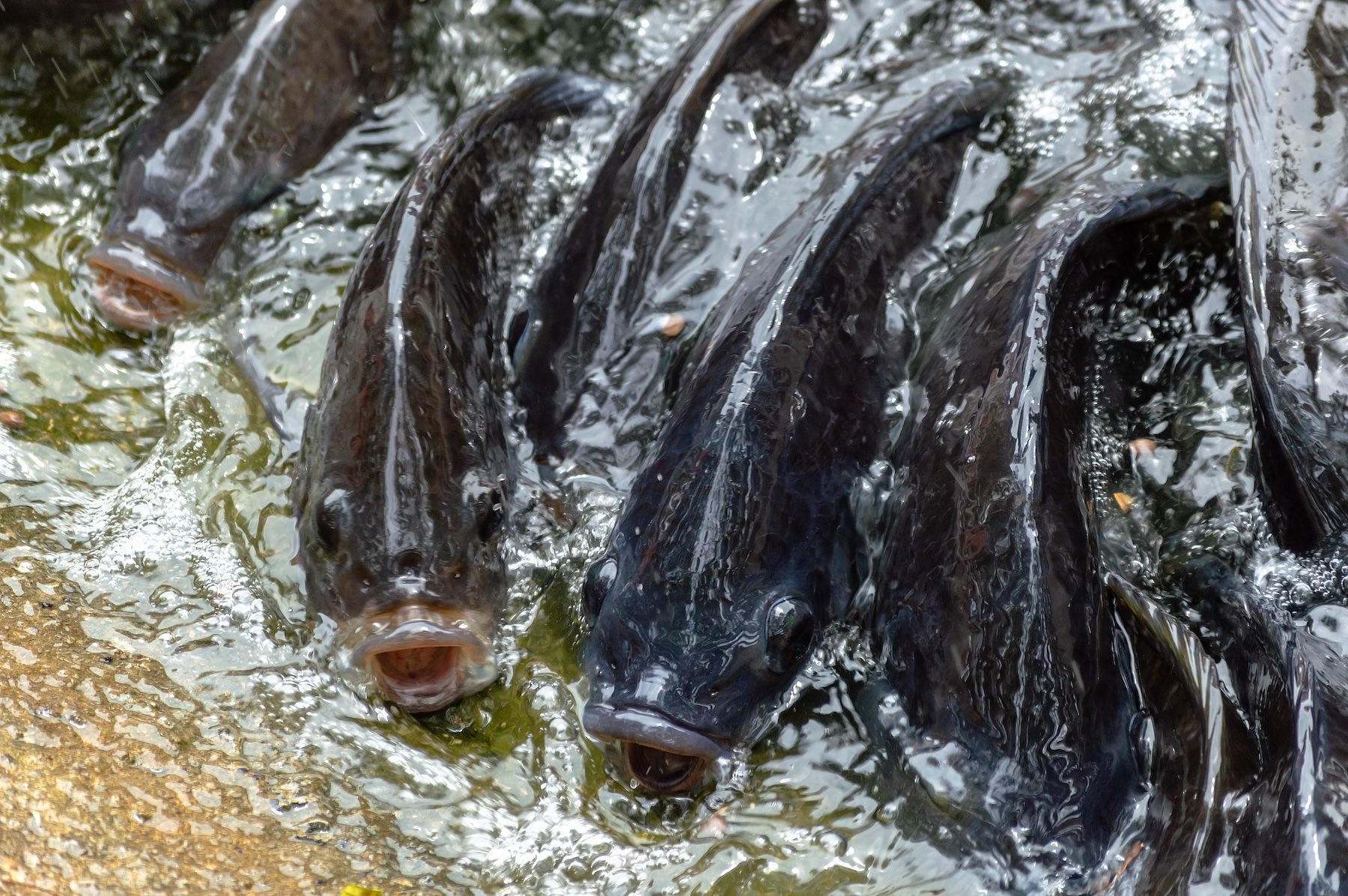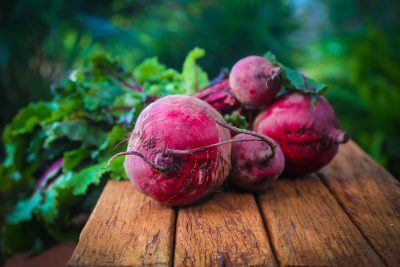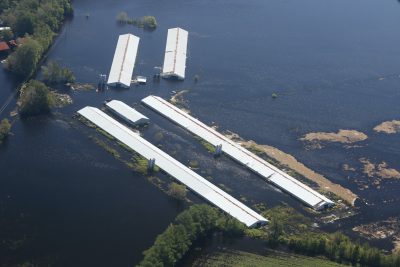Factory farming is not only a disaster for animals, it’s a disaster for us too. It creates a dangerous pandemic risk while at the same time driving antibiotic resistance. As if that wasn’t bad enough, it also damages our planet in multiple ways. Here we focus on just one: climate change.
What Is Factory Farming?
Factory farming is the highly industrialized process of mass-rearing and mass-slaughtering animals. It is the way that most farmed animals around the world are now raised – confined in vast numbers in small spaces, with every natural instinct thwarted.
Their feed, lighting and even breeding are all manipulated so that these sentient beings produce the largest amount of milk, eggs or meat, no matter the cost to their health and wellbeing.
Cows kept for their milk suffer infected teats and lameness; hens are caged and deliberately starved to force them to lay bigger eggs; pregnant pigs are confined in crates so small they cannot even take a step forward or back; and those chickens who don’t die from heart attacks may stand all day on broken legs.
There is no more ruthless system on earth, and there are few more reckless. Factory farming jeopardizes our very future on this planet.
How Much Does Factory Farming Contribute To Climate Change?
While some researchers place the figure much higher, the United Nations Food and Agriculture Organization says that 14.5 percent of all human-generated greenhouse emissions come from animal agriculture.
How Does Factory Farming Contribute To Global Warming?
The entire process of producing animal products creates greenhouse gas emissions, starting with the vast amount of crops that must be grown and processed to feed to animals (and for which we get back fewer calories in meat). Because so many crops are needed (and wasted), animal agriculture demands far more land than if we just ate plant-based foods. In fact, animal agriculture uses 83 percent of our farmland but gives us just 18 percent of our calories. This land has to come from somewhere, and all too often it is taken from nature, making animal agriculture a leading driver of deforestation.
Trees are heroes in the fight against climate breakdown because they absorb carbon from the atmosphere. But when we cut them down, not only do we stop their positive impact, we release the carbon they had already stored. It’s a devastating double whammy.
Another way factory farming drives climate breakdown is through emissions from the gargantuan amounts of slurry produced by all farmed animals, and from the digestive processes of ruminants. Manure contains nitrous oxide and methane, which have a global warming potential 265 times higher and 28 times higher respectively than carbon dioxide.
And then comes the energy-intensive process that turns living beings into food on shelves: slaughtering and dismembering, refrigerating and packaging. It all adds up to make animal farming one of the most damaging industries on the planet.
Some people argue that eating locally sourced meat, milk and eggs solves the problem but research shows that transportation is responsible for only a small proportion of greenhouse gas emissions from food. Environmental researcher and journalist George Monbiot explained that flying a banana six times round the world does less damage to the planet than eating beef or lamb from just down the road.
Six Facts Linking Factory Farming To Climate Change
It’s A Numbers Game
The more animals there are, the bigger the impact. More than 80 billion farmed animals are slaughtered every year – ten times the number of people alive – and two thirds of them are intensively farmed.
Burning Fossil Fuels
Animals eat so many crops that stealing land from wildlife is not enough. We have to boost production even further with fertilizers, and we burn fossil fuels to produce them. This releases up to 41 million metric tons of CO2 per year.
The Most Stupid Way To Feed A Nation
In North America, it takes five and a half calories of crops to produce just one calorie of animal products. All that land, all that fertilizer, all that waste! Whoever thought this was an efficient way to feed a nation has some questions to answer.
Excuse Me
Ruminants are particularly gassy. Emissions from digestive processes make up 39 percent of farmed animals’ greenhouse gas footprint.
Awash With Poop
Already, farmed animals produce an eye-watering, river-polluting, climate-destroying 3.5 billion tonnes of manure every year. While we continue to eat meat, that figure will continue to rise.
Factory Farming Fish Drives Climate Breakdown, Too
Fish farming is factory farming, too and Oxford University research found that a commonly used system of freshwater fish farming – one was actually thought to be environmentally friendly – instead produces a significant amount of methane.
What Is The Biggest Contributor To Climate Change?
In terms of economic sectors, two industries are virtually neck and neck when it comes to producing climate-destroying gases: the energy sector and agriculture.
What Is The Alternative To Factory Farming?
Some people believe that eating grass-fed beef does not contribute to climate breakdown. Unfortunately, those people are wrong. Oxford University researcher Joseph Poore says that no matter the system, cows produce a lot of methane: “Converting grass into [meat] is like converting coal to energy. It comes with an immense cost in emissions.” He is unequivocal: Grass-fed beef “is not an environmental solution”.
Poore’s wide-ranging work studying food production impacts on the environment revealed that even the most sustainable meat and dairy products still cause far more environmental harm than the least sustainable vegetables and cereals. And even the most sustainable dairy is worse for the planet than the least sustainable soya milk. Food for thought.
Eating local meat is not the answer. Eating grass-fed animals is not the answer. The honest answer is staring us right in the face: We need to massively scale down animal farming and preferably eradicate it altogether. Doing so will require every one of us to drastically reduce our consumption of animal products, or better still switch to a fully vegan diet. Even Poore himself became vegan as the evidence from his own research came into clearer focus.
He’s not alone. Environmental researchers the world over are saying the same thing. At Lund University in Sweden, for example, research uncovered the four best ways we can reduce our individual climate impact. Aside from limiting air and car travel and having fewer children, the researchers advised that we switch to a plant-based diet.
Conclusion
Animal farming is responsible for so much environmental destruction – from the pollution of air, earth and water, to deforestation and species loss, to climate breakdown.
Why would we willingly support the destruction of our home, let alone pay for it ourselves?
For the sake of our planet and our future on it, It’s time to choose vegan.






